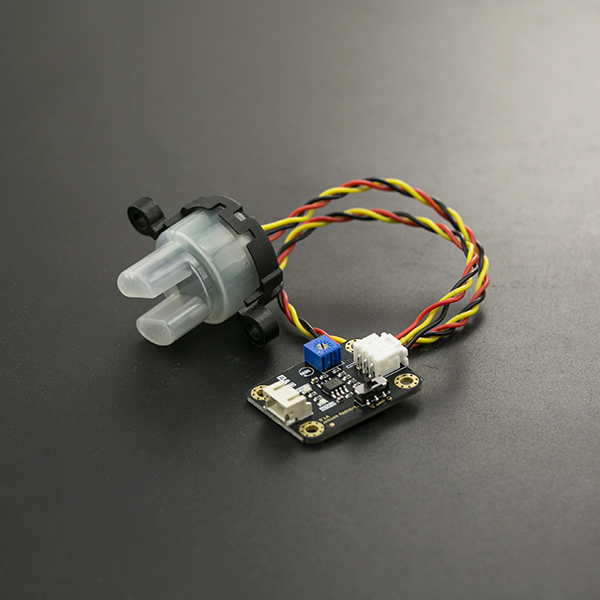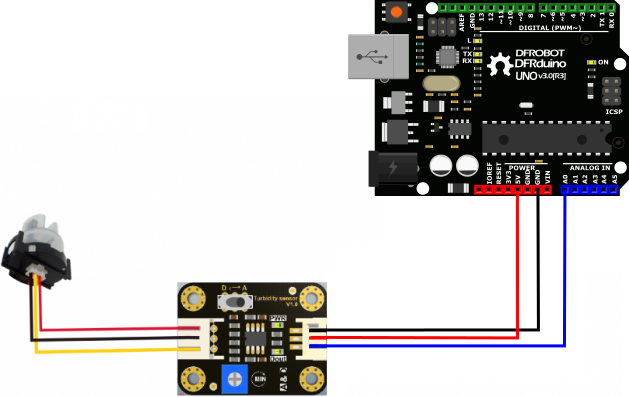-
Notifications
You must be signed in to change notification settings - Fork 5
Turbidity_sensor_SKU__SEN0189

The turbidity sensor detects water quality by measuring the levels of turbidity. It uses light to detect suspended particles in water by measuring the light transmittance and scattering rate, which changes with the amount of total suspended solids (TSS) in water. As the TTS increases, the liquid turbidity level increases. Turbidity sensors are used to measure water quality in rivers and streams, wastewater and effluent measurements, control instrumentation for settling ponds, sediment transport research and laboratory measurements. This sensor provides analog and digital signal output modes. The threshold is adjustable when in digital signal mode. You can select the mode according to your MCU.
 note: the top of probe is not waterproof.
note: the top of probe is not waterproof.
- Operating Voltage: 5V DC
- Operating Current: 40mA (MAX)
- Response Time : <500ms
- Insulation Resistance: 100M (Min)
- Output Method:
- Analog output: 0-4.5V
- Digital Output: High/Low level signal (you can adjust the threshold value by adjusting the potentiometer)
- Operating Temperature: 5℃~90℃
- Storage Temperature: -10℃~90℃
- Weight: 30g
- Adapter Dimensions: 38mm*28mm*10mm/1.5inches *1.1inches*0.4inches

Interface Description:
-
"D/A" Output Signal Switch
- "A": Analog Signal Output, the output value will decrease when in liquids with a high turbidity
- "D": Digital Signal Output, high and low levels, which can be adjusted by the threshold potentiometer
-
Threshold Potentiometer: you can change the trigger condition by adjusting the threshold potentiometer in digital signal mode.
Here are two examples: Example 1 uses Analog output mode Example 2 uses Digital output mode Example 1
void setup() {
Serial.begin(9600); //Baud rate: 9600
}
void loop() {
int sensorValue = analogRead(A0);// read the input on analog pin 0:
float voltage = sensorValue * (5.0 / 1024.0); // Convert the analog reading (which goes from 0 - 1023) to a voltage (0 - 5V):
Serial.println(voltage); // print out the value you read:
Delay(500);
}
Example 2
int ledPin = 13; // Connect an LED on pin 13, or use the onboard one
int sensor_in = 2; // Connect turbidity sensor to Digital Pin 2
void setup(){
pinMode(ledPin, OUTPUT); // Set ledPin to output mode
pinMode(sensor_in, INPUT); //Set the turbidity sensor pin to input mode
}
void loop(){
if(digitalRead(sensor_in)==LOW){ //read sensor signal
digitalWrite(ledPin, HIGH); // if sensor is LOW, then turn on
}else{
digitalWrite(ledPin, LOW); // if sensor is HIGH, then turn off the led
}
}
This is a reference chart for the mapping from the output voltage to the NTU according to different temperature. e.g. If you leave the sensor in the pure water, that is NTU < 0.5, it should output “4.1±0.3V” when temperature is 10~50℃.

 Note: In the diagram, the unit measuring turbidity is shown as NTU, also it is known as JTU (Jackson Turbidity Unit), 1JTU = 1NTU = 1 mg/L. Refer to Turbidity wikipedia
Note: In the diagram, the unit measuring turbidity is shown as NTU, also it is known as JTU (Jackson Turbidity Unit), 1JTU = 1NTU = 1 mg/L. Refer to Turbidity wikipedia
There are no questions about this product yet, if you have any problems or suggestions, you are welcome to email to us or post on our Forum!
| For any questions/advice/cool ideas to share with us, please visit DFRobot Forum |
Schematic
Probe_Dimension
Adapter_Dimension
 get it from dfrobot store or dfrobot distributor.
get it from dfrobot store or dfrobot distributor.